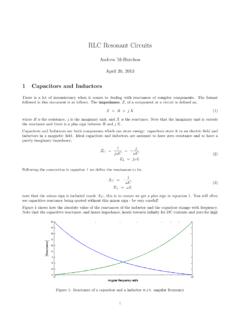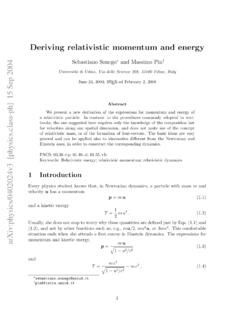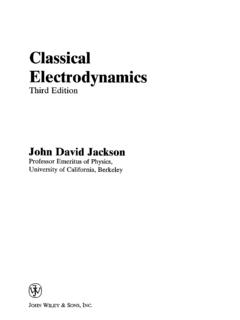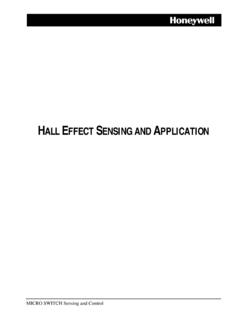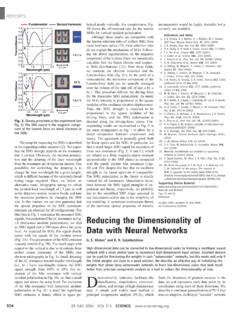Transcription of Electromagnetism Laws and Equations
1 Electromagnetism laws and EquationsAndrew McHutchonMichaelmas 2013 Contents1 ElectricE- andD-fields .. Force .. electric fields .. Gauss s Law .. Coulomb s Law .. Electric Potential .. difference in a capacitor .. Capacitors .. to capacitors .. capacitance .. force between plates .. The Method of Images ..82 MagneticH- andB-fields .. Ampere s Law .. Faraday s Law .. The Lorentz Force .. The Biot-Savart Law .. 121 ElectricE- andD-fieldsElectric fields are linear (obey superposition), vector the electric field strength andDis known as theelectric flux density. They are related by:D= 0 rEwhere, 0is thepermittivity of free space, and ris therelative permittivity. TheD-field is independent of thematerial, whereas theE-field is not.
2 This is an important use ofD. The product 0 ris often written . Electrostatic ForceThe electric field strength and the force exerted on a charged particle by the field are related by,F=Eq(1)whereqis the charge on the particle in Uniform electric fieldsA uniform field is one in which the electric field is the same at every point. It is most commonly encounteredbetween two parallel, conducting plates, ignoring edge effects. The equation for the magnitude of the electric fieldin this setup is:E= Vd(2)where,Vis the voltage difference, anddthe distance, between the plates. The electric field flows from the positiveplate to the negative, the opposite direction to the direction of increasing voltage; this results in the mistake: equation 2 is only valid for uniform electric fields, a common mistake is to use equation 2 fornon-uniform Gauss s LawGauss s Law is a cornerstone of electrostatics.
3 It is primarily used to relate electric field strength to s law states that: The net electric flux through any closed surface is proportional to the enclosed electriccharge:Q= SD dA(3)where,Qis the enclosed charge,Dis the electric flux density at area elementdAof closed a vectorand its direction is normal to plane of the area element, pointing to the outside of the Gaussian surface. Gauss slaw is true foranyclosed surface. However, if we can choose the surfaceScarefully the equation can be simplifiedsignificantly: we aim to choose a Guassian surface such that, parallel everywhere onS2. the magnitude ofDis constant everywhere onSThe first condition reduces the dot product to just the product of the magnitudes. The second condition allows themagnitude ofDto be taken out of the integral, as it is not a function of the position on the surface.
4 These stepsallow the manipulation of equation 3 as follows,Q= SD dA=D SdA=DA(4)whereAis the total area : This simplification only holds ifD dA!An example:Using Gauss s Law, find the electric field strengthEat a distancerfrom a point the Gaussian surface to be a sphere of radiusrcentred on the point charge, as shown in figure 1. Fora particular value ofr,Dhas constant magnitude and is perpendicular to the surface, therefore the integralbecomes,Q=D SdA=D 4 r2E=Q4 r2(5)This is a derivation of Coulomb s Law. Gauss s Law is often written in terms ofErather thanD. The result isexactly the same (indeed we convertedDtoEin the above example).Common mistake: consider the following question: find the electric field at a distancerfrom the centre of auniformly charged sphere of radiusr0, wherer > r0.
5 As with the point charge, the field lines are radial and sowe want to use a sperical Gaussian surface. A common mistake is for students to set the radius of the Gaussiansurface to be fixed value ofEcalculated using Gauss s law is found on the Gaussian surface. Thereforeusing a sphere ofr0only calculates the electric field at the surface of the sphere and not a general locationras thequestion asked us to do. If you are asked to find the electric field at a distancerfrom the centre of the sphere youmust use a Gaussian surface with a radiusrnot with 1: Gauss s Law applied to a point charge. The electric field lines are straight, radial lines and so we choosea spherical Gaussian surface, with a variable Coulomb s LawCoulomb s Law describes the electrostatic interaction between two charged particles.
6 It can be derived by combiningthe equation for the electric field around a spherical charge, equation 5, with the equation for electric force, equation1. It is an inverse-square law, and is given by:F21=q1q24 r2 r21(6)where,F21is the force on particle 2 from particle 1,ris the distance between the particles, and r21is a unitvector in the direction of particle 2 from particle 1. Note that when both particles have the same sign of chargethen the force is in the same direction as the unit vector and particle is repelled. Take care to get the particlesthe correct way around - are you calculating the force on particle 1 or 2? Does the unit vector point in the rightdirection? Electric PotentialThe electric potential of a point is the amount of work that has to be done, per unit charge, to move a pointcharge from a place of zero potential to that point.
7 This is the electric potential energy of the point divided by thecharge at that point - or electric potential energy per unit charge. The difference in electric potential between twopoints is what we commonly refer to as voltage - orelectric potential difference. Both of these quantities have SIunits of volts. An analogy to electric potential is gravitational potential - or gravitational potential energy per equation for the electric potential of a pointpis given by the line integral,V(p) = CE dl(7)whereCis an arbitrary curve which connects a point of zero potential to the pointp,Eis the electric field that isexperienced by the curve elementdl. Note that the integral involves a dot product, which indicates that the electricpotential is only changed when the curve moves with or against the electric field, rather than perpendicular to ,note the minus sign!
8 This comes about because electric potential is increased when the curve element is inthe opposite direction to the electric field, that is, our imaginary charge is being movedagainstthe electric should be familiar: potential energy always increases with movement against a than evaluating the integral from a point of zero potential, more often it is useful to define the equation interms of potential difference:V(p2) V(p1) = p2p1E dl(8)3whereV(p2) andV(p1) are the electric potentials atp2andp1respectively, and the integral is evaluated alonganycurve joining the two points. Note which way aroundV(p2) andV(p1) are, the same order as the is veryeasy to make a minus sign mistake here, always label clearly on a diagram where 8 allows you to compute the potential difference between any two points in a electric field.
9 The integralin equation 8 is over a dot product between the electric field and any path between pointsp1andp2. For simplesetups, such as the ones you will come across in Part 1A, we can often choose this path to be parallel to the electricfield and hence replace the dot product with the product of magnitudes, in a similar way to Gauss s Law. However,we generallycannottake the electric fieldEoutside the integral, like we did with Gauss s Law, as the electric fieldwon t be constant between the two points, the magnitude ofEis a function only be taken out ofthe integral in equation 8 in uniform electric fields, between parallel mistake: to not treatEas a function ofland to take it out of the example: Consider the setup shown in figure 2. We want to calculate the potential difference ofp2relative top1resulting from the electric field created by the point 2: The setup for the potential difference worked example.
10 The question requires us to find the potentialdifference between the pointsp1andp2in the presence of the electric field created by the point our first solution we shall pick the pathCto be a straight line fromp1top2. We parameterise the path by thevariablex, the origin of which we set to be at the pointO. We also define unit vectorsiwhich points alongCandjin the perpendicular direction toC, as shown. This gives,C=xi dl=dxi(9)We will integrate fromp1atx= 1 top2atx= 4. In order to solve the integral in equation 8 we need to write theelectric field in terms of our variable of integration,x. By using Gauss s Law or Coulomb s law and figure 2 we canwrite,E=Q4 r3r(10)=Q4 (x2+ 32)3/2(xi+ 3j)(11)4where,r=r r, which is why we divide byr3. Combining with equation 8,V(p2) V(p1) = p2p1E dl= Q4 411(x2+ 32)3/2(xi+ 4j) dxi= Q4 41x(x2+ 32)3/2dx=Q4 [1 x2+ 32]41=Q4 [15 1 10](12)We could have made this calculation easier by careful choice of the path fromp1top2(remember we can chooseany path we like).
